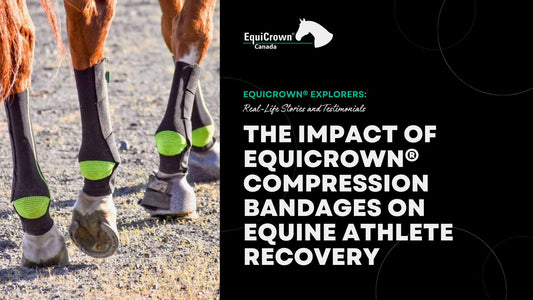
The Impact of EquiCrown® Compression Bandages on Equine Athlete Recovery
Based on an article by Sherry Johnson, DVM, MS, DACVS, DACVSMR, available at here
Table of Contents
- Introduction
- Recovery Acceleration Strategies in Human Athletes
- EquiCrown Compression Bandages in Equine Athletes
- Conclusion
1. Introduction
This article discusses the use of EquiCrown compression bandages in equine athletes, focusing on the research findings from the study conducted by Sherry Johnson, DVM, MS, DACVS, DACVSMR. The study investigates emerging rehabilitative approaches in human and equine athletes, providing an overview of the research supporting their translational use.
2. Recovery Acceleration Strategies in Human Athletes
In human athletes, recovery acceleration is increasingly important, as it helps minimize days out of competition and speed up active recovery. Various strategies, such as stretching, massage, and compression garments, are used to achieve this goal. These strategies work by accelerating lymph circulation, which has been demonstrated to beneficially remove metabolic products, improve body fluid dynamics, cause changes in microcirculation, and reduce venous blood return.
Although several methods exist to improve human lymphatic flow, including mechanical stimulation, deep oscillation, and physical stimulation, a lack of universal clinical practice guidelines makes it difficult to determine the best approach for sports medicine and rehabilitation.
3. EquiCrown® Compression Bandages in Equine Athletes
EquiCrown® compression bandages offer a method for improving lymphatic flow in equine athletes. These medical-grade bandages, custom-fit based on anatomic measurements, help maintain distal to proximal pressure gradients based on the contour of an individual horse's limb. When combined with contrast therapy, appropriate exercise, retrograde massage, and titrated, supervised application, these bandages have resulted in significant clinical improvements of chronic distal limb edema/lymphedema based on serial, circumferential limb measurements.
In addition to the compression wraps, full limb pneumatic compression technology with automatic cycling is being tested, working to dynamically push lymphatic fluid retrograde in between cycles. This technology shares the same manufacturer and pump system as the FDA approved human device and is currently being investigated for the treatment of lymphangitis and athletic recovery in horses.
As further research is conducted to investigate the specific application parameters and correlation to performance outcome measures, more recommendations can be expected in the future.
4. Conclusion
EquiCrown® compression bandages have shown promise in accelerating recovery for equine athletes by improving lymphatic flow and addressing chronic distal limb edema/lymphedema. As more research is conducted to determine the best application parameters and understand the correlation between these bandages and performance outcomes, the use of EquiCrown® compression bandages is likely to become more widespread in equine rehabilitation and athletic recovery.

